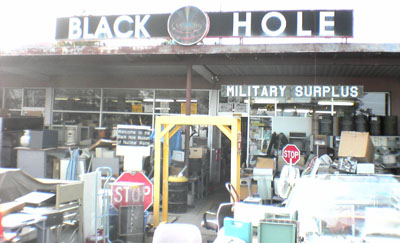TSA watchlist, here I come
So I’m packing for my flight to Beijing last night. I decide to wear my running shoes on the flight to Tokyo since I have a five hour layover there and can workout at a nearby gym. I get to the airport this morning and as I’m standing in line at security it hits me. These are my robo-shoes. The shoes I hacked (literally) to include the Nike+iPod pedometer. Not good.
I could see it all happening before my eyes. A vigilant TSA employee sees something odd on my shoe x-ray. He asks me to explain.
“Well, sir, see this thing in my shoe is a transmitter.”
A single eyebrow raises. “Continue.” He presses the silent alarm button.
“You control it from this remote here.”
“OK, can you show me?”
“Sure,” I say pulling out the orthotic insert. “See this is where I drilled a hole in the gel insert to put the transmitter in.”
“Gel, did you say?”
Gulp.
OK so thankfully that was only a vision. But the trickier problem was finding a place in line to take my shoe off, disassemble it, and pop the transmitter out without causing a panic in the line. Hi there, excuse me, sorry to bump you — just fishing a small device out of a hidden compartment in my shoe. Nothing to worry about.
Oh, colored terror alert scale! Is there any limit to the ways you can entertain me?
Threatdown
Amazingly today was the first time I’d flown since the terror plot in London was foiled. Certainly there was plenty of B-grade security theater from the TSA, but I was surprised to consider how all this threat level nonsense may fundamentally change how I travel and, possibly, how I work.
So I packed last night for a two-day overnight trip. Backpack for computer, small rolling bag for clothing. Nothing special. Once in the airport I realized I needed to dump the sanitizing hand gel from my backpack. Still no big deal. My fault for not remembering. Then, as my overnight bag was being scanned it occured to me that I had toothpaste, shaving cream, mouthwash, and other liquids in there that’d need tossing. Instead, I got out of line and checked it. OK, fine, so again I forgot. But that’s the thing. This latest ban basically means no carry-on overnight luggage. Which means no quick on-off of the plane or in-out of airports.
I know, I should have known and packed/checked accordingly. But the point is, this might actually push me to reconsider overnight trips. I’d rather destroy myself with a first-flight-out last-flight-back daytrip than have to wait at baggage claim or, worse, risk losing it because I checked it. And there’s a difference in the amount of work you can get done in one day than in two (or three). All because some idiot terrorists who never would have pulled off their plan succeeded in terrorizing us anyway.
The worst indignity? Well, I was smart enough to know that I could not bring a cup of coffee through security (though many others were pissed to have to dump out their fresh cups). So I bought a cup on the other side of security. Two sips in boarding began and I was told that I needed to dump it. Say what? Dump this coffee in a secure zone? What could I have done to it? Did they suspect the coffee kiosk has doctored the beverage? And if there is concern about liquids past security shouldn’t that problem be tackled at the source, rather than letting travellers buy the beverages in the first place? This is such lunacy.
Can’t wait for my international trip on Saturday.
Mileage whore
When I was new to business travel I proudly called myself a mileage whore. I’d do just about anything for an upgrade or extra frequent flyer miles. Recently I heard a scheme from an acquaintance that puts my hijinks to shame. In fact, I think it crosses the line.
This person, let’s call him FlyGuy, makes it a contractual stipulation of employment that he will use his own frequent flyer miles for normal business trips (not upgrades) if his company will reimburse him for 75% of the face ticket value. The pitch (he’s a salesman) is that this saves the company 25% on every ticket. The company loves it and they do it. This is how he travels.
First things first. To me, it matters how you accumulated these miles. If they are 100% from your own out-of-pocket expenses in a way this is a fair trade. Sort of. (More on that in a second.) But the reality is that most miles are acquired through business travel, paid for by your company. FlyGuy has been with a number of companies, mostly start-ups, so his balance (I reckon) is comprised of miles originally paid for by different companies.
The point is that he is actually earning income by cashing in a “credit” obtained from money spent by an employer.
Now, you will say, this is a personal perk that is his to do with as he pleases. And if his company is willing to go along with it, what’s the harm? Two things. First, FlyGuy is essentially selling a benefit given by his company back to his company. Like saying, no thanks I’ll pass on the dental plan so pay me $2000 extra.
Second is the potential for abuse. Consider this scenario: You can choose between two flights to NYC. One leaves at 6AM and costs $200, the other leaves at 7AM and costs $600 (for whatever reason, discrepancies like this happen all the time). You’re going to choose the $600 ticket because you’ll “earn” $450 rather than $150. The frequent flyer mileage required to obtain the ticket is, presumably, identical since it is the same route. Where is the incentive to go with the lowest fare? There isn’t one. The incentive now is reversed. In reality the employer may be saving 25% but paying for a more expensive base ticket than they would otherwise have to.
Airlines do offer the ability to purchase frequent flyer miles. They are pretty costly, but if you had to have a scheme like this it seems a fairer trade to have your employer pay what you’d have to pay to buy the miles rather than to buy the ticket.
I have a feeling many of the business travellers who read this blog will disagree with me. Comments welcome.
What a smile ’round my face
Yikes, it has been a silent week ’round these parts. My travels in China have been crushing: a full work day on Beijing time plus 75% of a work day on US time. While this makes for a lot of time in front of the computer it does not produce much of a clear head for blogging. And this is why I am writing now from my flight 35,000 feet above the Pacific. This is my first flight with WiFi broadband and I just need to geek out a bit and say this changes everything. Time was, international flights were like day-long technology isolation chambers, but now that I have a connection (and a pretty fast one at that — 802.11g) it gets all screwy. I’m adapting my already nutty sleep schedule to Chicago time so that I can Skype with my wife. And the beauty of that, of course, is that we just leave it on the entire flight. She hears me; I hear all the goings-on at home. — for 10 hours. Just like ignoring each other at our own computers when we are under the same roof. Seriously though. This changes so much. I’ve watched streaming video, listened to iTunes radio, videoconferenced with a pal, Skyped my wife, and obviously e-mailed and surfed. Am I overdoing it this time? Absolutely. Will this go down as the best thing to happen to me before my baby arrives in a few weeks. Absolutely.
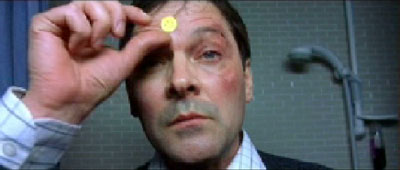
International travel alone is rough, but for some reason Four Tet’s “Smile Round the Face” cheers me up every time I watch it. It took me a few viewings to realize what seems so obvious: being a daddy is it’s own reward. Thanks, Kieran, for the cheer.
More China double happiness soon …
The discards of Los Alamos
I’ve spent much of the past week hearing about the latest in museum technology. There were even organized outings to the museums in and around Albuquerque for us to get a gander firsthand. Strangely none of the organized tours included The Black Hole Museum of Nuclear Waste in Los Alamos.
Run for over 50 years by a guy named Edward Grothus, the museum is more like the backlot of a Mad Max film. In fact, in an irony I am certain is not lost on Grothus the place looks exactly like some archaeology dig where future humans are uncovering the remains of a once-great society’s technology after a nuclear catastrophe. He has built, in other words, that which he hopes to prevent. You might think a “museum” to the scraps of Los Alamos is some kind of reverential exercise, but there’s actually a peace theme that runs throughout, as if Grothus were hoarding all this utterly useless stuff (vials of Liquid Paper!) because he doesn’t want its bad karma let loose in the wild. Of course, it does get out; he sells it. But what sells can only be a tiny fraction, because most of the stuff you could simply stroll through Office Depot for. And it is reverential, in a way, as Grothus conducts a “Critical Mass” every Sunday in a huge A-frame “church” next door.
The technological gizmos are the most interesting for sure. All kinds of specialized and worrisome componentry sits amidst computers of bygone eras. It is like a library once-removed where you walk through wondering what documents, equations, and national security communiques issued from the teletypes and keyboards.
A fascinating museum, if ever there was one. Highly recommended. Bugs, I’m glad I took that left turn at Albuquerque.
Photo tour at Flickr.
Ghostface
Was the mask in the Scream trilogy inspired by a cave formation in Bandelier National Monument Park in New Mexico? It’s commonly held to have been inspired by Edvard Munch’s The Scream, but I’m going with the theory that Wes Craven is a hiker.
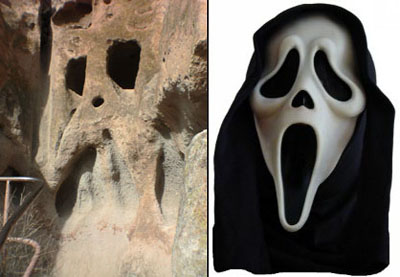
Turkish delight
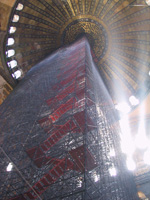
I had a free day today in Istanbul and made much of it. First to the Haghia Sophia, main church of the Roman (eastern) Empire under Theodosius. From a distance one is struck by the bulbous rooftop, domes and half-domes crowding inwards like a complex multi-chambered soap bubble. Converted to a mosque after the Arab conquest it has since been converted to a museum after the Tourist conquest. That is, it is no longer a sacred place. Just a husk of former greatness and object of rivalry for iconic supremacy. It was actually a bit depressing. The synthesis of Christianity and Islam — which could actually be stunning if you think about it — stirs no soul. The whole place seems barren and dilapidated. I suppose this is what happens when you take a holy space away from a religious organization who cares about it and give it over to a ministry of tourism. The Byzantine mosaics were stunning, though. My appreciation for the style has grown faster and more complete than any once-dismissed art I ever studied in college, I can say that. Full picture set here.
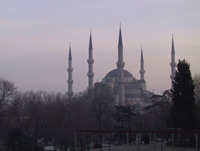
The Blue Mosque nearby the Haghia Sophia was actually more spectacular. The only mosque in Istanbul with six minarets it looks from a distance like an enchanted Alpine castle. It is a functional mosque too, so the interior is as striking as the outside — a real contrast to the decaying taxidermy feel of the Haghia Sophia interior. Nearby the Blue Mosque is a oval roadway that follows the course of a Roman hippodrome course. The interior is now a lovely park skirted not with charioteers but cafes. Which brings me to nargile — the Turkish shisha pipe, hookah, water-pipe, hubbly-bubbly, call it what you will. I’ve been to a few nargile cafes now and I can compare them to their Egyptian counterparts. In Turkey it seems you smoke the nargile as a pastime while playing backgammon or checkers whereas in Egypt you smoke it, um, just to smoke it. Nargile cafes are amazingly social places. Tables are arranged for interaction. Egyptian shisha cafes have their own charms, but they are mostly for smoking and watching a television turned up way too loud to a music channel. I’d say Egyptian shisha is finer and more varied, but I prefer the culture of the nargile cafe.
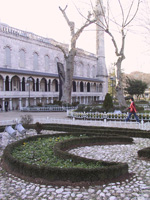
I made it to a Turkish bath house today. It was old (commissioned in 1584) and traditional but, alas, in a bit of a touristed area, though I was definitely the only American and probably the only Westerner in the place. My beloved baths in Chicago bill themselves officially as the Division Street Russian and Turkish Baths, but I’m struggling to find commonality between the experience in the bathhouse today and the one back home. There were no obese men, no oak switches, no freezing pools, no eucalyptus steamrooms. The Turkish bath today felt more like a Roman basilica. A central, domed room houses most of the action. It is warm but not sauna-like. The all-marble room features a central raised octagonal slab on which men lounge and are scrubbed by other men. There are domed niches with running water — bearing a real resemblance to side chapels in medieval churches — where you can hang out as well. The experience centers on a kind of vigorous scrubdown, though. This is no massage. For one, you’re on hard marble. For another, these gentlemen are probably former interrogators from the Turkish military. Despite the presence of soap and a loofah glove the whole thing is like a wrestling match where you’re not allowed to fight back. I was certain I’d be left paralyzed on the slab as my scrubber treated my spine like a flexi-straw. I yelped in pain more than once which elicited the only English word my friend apparently knew, a hearty “YES!” It was invigorating to be sure, but not really a bath in the sense of a place where one bathes. ‘Course you can’t beat the nargile-bathhouse one-two punch, so I’m not complaining.
That is no country for old men.
Istanbul delights.
East meets West is cliche — so how about this? If Europe and Asia were kissing, the Bosphorus would be their swapped saliva. Actually I feel less of the Asian influence and more of the Middle Eastern though certainly Westernism is dominant. I’ve only been here for a few days, but I have this overwhelming sense that Turkey is a key to helping the West and Islam carry on a useful conversation. Of course, as anywhere the press focuses on extremes — at the opening today of a new anti-American Turkish film on the Iraq war a U.S. diplomat was quoted as saying it “does not purport to be a factual version of events” while an exiting moviegoer was quoted as saying it “should make Americans see why the world doesn’t like them” — but this ignores the majority between the poles. Turkey — perhaps Istanbul only, so I generalize — has a proud tradition of multicultural tolerance and is especially proud of its merger of Western notions of spiritual freedom and Islam. One colleague here described it to me as a “pre-secular secularism.” That is, a tradition of religion being between one’s self and god that pre-dates the various massive religious institutions that have called Istanbul home.
Meanwhile, the Muslim world ignites over cartoons of their prophet and the West hoists the standard of free speech. At least one member of the Turkish administration has voiced concern that freedom of speech has limits. Not having travelled extensively here and knowing that Turkey has had its share of bomb-wielding idiots I can’t say I know what the populace thinks. Still, I think the mostly-happy symbiosis of occidental outlook and Muslim mores bears study as the world struggles to figure out how to to de-escalate tensions.
Two days ago I spent most of my time at the Topkapı Sarayı, palace of the Ottoman sultans from 1465 to 1853. It is an interesting complex, so much more human-scale than the Forbidden City in Beijing, though the similiarities and timeline of the twilight of the Ottoman and Qing empires is interesting to consider together. By far the most visited section of the palace is the harem. Empty, of course, the harem still captivates imagination. Almost like softcore porn, the empty rooms titillate with what might have been.
The museum halls are well done. Small selections or jewels, arms, and gifts from foreign potentates make up the majority of the collection. There is s special hall devoted to religious icons. The irony is that I had only just finished noting the Catholic obsession with saintly body part idolatry when we stumbled on the holy relics hall. There I saw pieces of the prophet Mohamed’s beard, his tooth, and a foot imprint. For a religion so faithfully non-representational (see cartoon furor) this seemed all very odd to me. There was also a letter from Mohamed to the Copts (Egyptian Christians) entreating them to join his tribe and faith and, stranglely, a gold-encased severed arm of John the Baptist. In the relic room a müezzin sat in a glass-enclosure like a UN translator and sang lines from the Koran.
One of the highlights were talismanic tunics covered in the tiniest Arabic script I’ve ever seen. Entire books from the Koran had to be inscribed on a single shirt. An impressive and literal embodiment of the holy word. Word made flesh, so to speak.
Once out of nature I shall never take
My bodily form from any natural thing,
But such a form as Grecian goldsmiths make
Of hammered gold and gold enamelling
To keep a drowsy Emperor awake;
Or set upon a golden bough to sing
To lords and ladies of Byzantium
Of what is past, or passing, or to come.
– WBY
≠ Constantinople
I’m headed to Istanbul for work next week. My first time there. I’ve yet to meet anyone who has visited and not been bowled over by the place. Having travelled extensively in Europe and moderately in the Middle East and being a lover of nearly everything Mediterranean I am more than a little excited. I’m still trolling for tips on things to do. I’ll have an entire day to myself and I plan to make the most of it. For one, I’ll be searching for an authentic Turkish bath house — a task made a little easier because of some tips I received at the Turkish consulate today.
And there you have a key difference between the Turkish consulate and its Egyptian and Chinese counterparts. The Egyptian consulate (at least in Chicago) verily prints money from travellers with their bizarre fee structure and impersonal, single bank teller-like operation. The Chinese consulate, in contrast, is massive and patrolled (currently against Falun Gong protesters). Remarkably the Chinese have brought all the splendor of Maoist architecture to the interior of their Chicago offices. By the time you reach the window you’re ready to be collectivized. And do not mess with the schoolmarmish window attendant. I believe you will lose your pinky for doing so. (I wonder if consulates, like DC embassies, are technically on foreign soil and obey foreign laws?)
But the Turkish consulate was different. Open, airy, and not unlike a travel agent office. The clerk greeted me personally and led me to his office to fill out the paperwork. The detail so craved in other visa applications seemed secondary. I figured I would have to pay an expedite fee just to get my visa (and passport!) back on the day I left. But he asked if I would like it back at noon. Regular cost. Hey sure.
When I returned later in the day the clerk asked me to have a seat and tell me why I was going to Turkey. (I had no time, but I did anyway.) He was the nicest old guy, giving me tips and telling me that, unlike Chicago cops who love to ticket out-of-towners — he specifically said people from Wisconsin — Istanbul cops love foreigners. In retrospect I think he was either encouraging me to commit a crime in Turkey or testing to see if I was a criminal seeking asylum in his country. From this discussion came the Turkish bath recommendation. Not a tourist bath house, mind you, but where the locals go. No English spoken.
Perfect. Just what you want when surrounded by naked men.
Joey, have you ever been to a Turkish prison?
Three weeks until Torino
Really I was looking for an excuse to post this photo from a transalpine flight of a few years back, but the Olympics are three weeks away. I can’t wait to see how many countrymen take home the Olympic donut.

